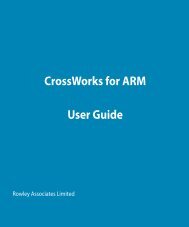RFBee User Manual v1.1
RFBee User Manual v1.1
RFBee User Manual v1.1
- No tags were found...
You also want an ePaper? Increase the reach of your titles
YUMPU automatically turns print PDFs into web optimized ePapers that Google loves.
<strong>RFBee</strong> <strong>User</strong> <strong>Manual</strong> <strong>v1.1</strong>Table of contents1 Overview ........................................................................................................................................................................... 21.1 Licensing .............................................................................................................................................................. 21.2 Specifications........................................................................................................................................................ 21.3 Electrical Characteristics ...................................................................................................................................... 31.4 Board layout ......................................................................................................................................................... 31.5 Microprocessor-Atmega168 ................................................................................................................................. 31.6 RF Transceiver-CC1101 ....................................................................................................................................... 31.7 Pin layout .............................................................................................................................................................. 41.8 Schematic.............................................................................................................................................................. 42 Hardware Installation ........................................................................................................................................................ 63 Configuration .................................................................................................................................................................... 83.1 Version .................................................................................................................................................................. 83.2 Out of the box ...................................................................................................................................................... 83.3 AT Commands ...................................................................................................................................................... 83.3.1 AT Format: ................................................................................................................................................... 83.3.2 Supported commands: ................................................................................................................................ 93.3.3 Output format ............................................................................................................................................. 113.4 Broadcasting ....................................................................................................................................................... 114 How to update firmware .................................................................................................................................................. 125 Revision History ............................................................................................................................................................. 13Page 1 of 13 8/27/2010
1 OverviewThe <strong>RFBee</strong> is a RF module providing easy and flexible wireless data transmission between devices. It is based on a AVRAtmega168 working as a fully functional Arduino connected via SPI to a TI CC1101 RF transceiver.Features:• Range: Indoor/Urban: up to 50m; Outdoor line-of-sight: up to 120m;• Receiver Sensitivity: -95dBm• RF Data Transmission Rate: 4,800bps; 76,800bps• Working Frequency : 868MHz & 915MHz• Communication type: Point to Point, or Point to Multipoint.• Easy-to-Use Serial Interface and rich extendable ports• Easy-to-Use AT Command: Set working mode, Serial Baud Rate, etc.• Open source Hardware and Firmware• Socket compatible with the Xbee, so you can plug it into any Xbee socket as a quick replacement.Note: only the Rx,Tx, VCC, GND pins are identical to the Xbee. RFbee’s will not communicate with Xbee’s, soRFbee’s need to be used on both ends of the wireless connection.1.1 LicensingThis documentation is licensed under the Creative Commons Attribution-NonCommercial-ShareAlike License 3.0.Source code of the Atmega 168 firmware used in the <strong>RFBee</strong> is licensed under GPL/LGPL, see source code files for details.1.2 SpecificationsSpecificationValueMicroprocessorAtmega168PCB size24.38mmx32.94mmx0.8mmIndicatorsNoPower supply 3.3vIO counts 9ADC input7(6 multiplexing with IO)Program interfaceUSBConnectivitySocket compatible with XBeeCommunication Protocol Uart(TTL)Operating Frequency Band ISM 868MHz & 915MHzOutline Dimension24.38mmx32.94mmx15mmPage 2 of 13 8/27/2010
1.3 Electrical CharacteristicsSpecification Min Typ Max UnitInput voltage 3.0 3.3 3.6 VDCTransmit Current 34.5 mAReceive Current 18.1 mAIdle Current 5.2 mAPower-down Current >Datasheet: http://www.atmel.com/dyn/resources/prod_documents/doc2545.pdf>>Arduino information: http://www.arduino.cc/1.6 RF Transceiver-CC1101The CC1101 is a low-cost sub-1 GHz transceiver designed for very low-power wireless applications. The circuit is mainlyPage 3 of 13 8/27/2010
intended for the ISM (Industrial, Scientific and Medical) and SRD (Short Range Device) frequency bands at 315, 433, 868,and 915MHz. The <strong>RFBee</strong> antenna and firmware are optimized for 868 and 915MHz.>>Datasheet: http://focus.ti.com/docs/prod/folders/print/cc1101.html1.7 Pin layoutPIN # Pad Type Description Arduino Pin Number [1]3V3 1 Supply input Vcc,+3.3v -TX 2 Output Uart Tx port 1(DIO)RX 3 Input Uart Rx port 0(DIO)PD4 4 Input/Output ATmega168 PD4 4(DIO)!RESET 5 Input ATmega168 Reset portPB1 6 Input/Output ATmega168 PB1 9(DIO)PB0 7 Input/Output ATmega168 PB0 8(DIO)PD7 8 Input/Output ATmega168 PD7 7(DIO)!DTR 9 Input Used for programming the ATmega168 -GND 10 GND GND -PC3 11 Input/Output ATmega168 PC3 3(Analog input)/17(DIO)PC2 12 Input/Output ATmega168 PC2 2(Analog input)/16(DIO)PC1 13 Input/Output ATmega168 PC1 1(Analog input)/15(DIO)VREF 14 Input ATmega168 AREF port -PC0 15 Input/Output ATmega168 PC0 0(Analog input)/14(DIO)ADC7 16 Input ATmega168 ADC7 7(Analog input)PD5 17 Input/Output ATmega168 PD5 5(DIO)PD6 18 Input/Output ATmega168 PD6 6(DIO)PC5 19 Input/Output ATmega168 PC5 5(Analog input)/19(DIO)PC4 20 Input/Output ATmega168 PC4 4(Analog input)/18(DIO)Note: [1] Pin Number can be used in Arduino functions, like pinMode(),digitalWrite(),analogRead(),etc..Page 4 of 13 8/27/2010
1.8 SchematicPage 5 of 13 8/27/2010
2 Hardware InstallationThe <strong>RFBee</strong> can be connected in various ways, e.g.: to a PC via USB using a UartSB device. to a Seeeduino (or Arduino) via an XbeeShield to any other device having a Uart portNote: the UartSB device and the XbeeShield are sold separately.>> UartSB: http://www.seeedstudio.com/depot/uartsb-v22-a-much-more-powerful-usb-to-serial-converter-p-495.html>> XbeeShield: http://www.seeedstudio.com/depot/xbee%C3%82%C2%AE-shield-v11-by-seeedstudio-p-419.htmlFigure 1: USB using UartSBPage 6 of 13 8/27/2010
Figure 2: Seeduino via XbeeShieldFigure 3: Any device using a UartPage 7 of 13 8/27/2010
3 Configuration3.1 VersionThis section documents the configuration of <strong>RFBee</strong> firmware version 1.1. You can check the version of your firmware byissuing the ATFV command.3.2 Out of the boxWhen powered on, <strong>RFBee</strong> will send “ok” through serial port at 9600 baud. The default operation mode is “Transceive“ andthe default sender and receiver address is 0. If you have two <strong>RFBee</strong>’s, any data submitted to the serial port of <strong>RFBee</strong> A willbe emitted by the serial port of <strong>RFBee</strong> B.3.3 AT CommandsThe configuration of the <strong>RFBee</strong> can be modified using AT commands. At startup the <strong>RFBee</strong> is in data mode. To submit ATcommands, the <strong>RFBee</strong> must be switched to command mode by sending three plus signs (“+++”).When the <strong>RFBee</strong> receives the three plus signs on the serial port it will respond with: “ok, starting command mode”. The<strong>RFBee</strong> is now in command mode until switched back to data mode (using ATO0 see below) or power reset.3.3.1 AT Format:AT + Comand(ASCII) + parameters (optional, character)+Where is Carriage Return which has binary value 13 (0x0D in Hex) .Example:+++ - Go to command mode, the <strong>RFBee</strong> will return “ok, starting cmd mode”ATBD1 - Set Uart Baudrate of the <strong>RFBee</strong> to 19200, returns “ok” on success and otherwise “error”.ATBD - Get Uart Baudrate of the <strong>RFBee</strong>, returns “1” and “ok” on success and otherwise “error”.ATO0 - Go to datamode, the <strong>RFBee</strong> will return “ok” and any data send afterwards will be transmitted again.Page 8 of 13 8/27/2010
3.3.2 Supported commands:Command Parameter Specification Default TypeAdressingRFAC 0-2Address Check: determines whether the<strong>RFBee</strong> checks the incoming packetaddress against its own address or not. Ifbroadcast is enabled both its own addressand the broadcast 0 address will beconsidered valid.0:No address check1:Address check, no broadcast2:Address check and broadcast0 r/wMA 0-255 My Address: set the <strong>RFBee</strong>’s own address. 0 r/wDA 0-255PA 0-7CF 0-5Destination Address: set address of thereceiverPower Amplifier: Set RF transmittingpower.0:-30dBm1:-20dBm2:-15dBm3:-10dBm4:0dBm5:5dBm6:7dBm7:10dBmConfig:select radio config0: 915 Mhz, 76,8 Kbps, 2-FSK1: 915 Mhz, 4.8 Kbps, GFSK, sensitivity2: 915 Mhz, 4.8 Kbps, GFSK, low current3: 868 Mhz, 76,8 Kbps, 2-FSK4: 868 Mhz, 4.8 Kbps, GFSK, sensitivity5: 868 Mhz, 4.8 Kbps, GFSK, low current0 r/w7 r/w0 r/wPage 9 of 13 8/27/2010
Supported commands continued from previous page:Command Parameter Specification Default TypeSerialModeDiagnosticsBD 0-3TH 0-32OF 0-3MD 0-3BaudRate: Set Uart Baudrate of the <strong>RFBee</strong>.0: 9600bps1: 19200bps2: 38400bps3: 115200bpsThreshold: Set threshold in bytes that willtrigger <strong>RFBee</strong> to start transmission.Output format (see also section below)0: payload only1: source, dest, payload2: payload len, source, dest, payload, rssi,lqi3: same as 2, but all except for payload asdecimal and separated by comma'sMode: Set working mode of the <strong>RFBee</strong>.0:transceive1:transmit only2:receive only3:lowpower (using Wake-On-Radio)0 r/w1 r/w0 r/w0 r/wO 0 Online: return to data mode wSL -Miscelaneous RS -Sleep: Put the <strong>RFBee</strong> to sleep to reducepower consumption, the Atmega will be inSLEEP_MODE_IDLE, the CC1101 in SPWD,activity on the serial port will wake the<strong>RFBee</strong> again.FV - Firmware version 1.1 rHV - Hardware version . rRestore: restore the configuration todefault settings.w- wPage 10 of 13 8/27/2010
3.3.3 Output formatUsing ATOF it is possible to change the output format of data packets received.ATOF set to 0:PayloadATOF set to 1:Source addressDestination addressPayload(1 byte)(1 byte)ATOF set to 2:Source addressDestination addressPayload lengthPayloadRSSILQI(1 byte)(1byte)(1 byte)(1 byte)(1 byte)ATOF set to 3:As ATOF2, but now all byte values (except Payload) displayed as decimal and all fields separated by comma’s.RSSI: Received Signal Strength Indicator. One byte signed data, unit dBm.LQI: Link quality indicator. One byte data, see CC1101 datasheet for details.3.4 BroadcastingWhen every <strong>RFBee</strong> has it’s a unique address assigned (e.g. 1,2,3 and 4 if you have 4 <strong>RFBee</strong>s) there are two ways to let all<strong>RFBee</strong>’s receive the same packets:1. Set ATAC to 0: this will disable address checking and all <strong>RFBee</strong>’s will receive all packets sent. Downside of this isthat any “private” communication between e.g. 2 and 3 will always show up at 1 and 4.2. Set ATAC to 2: this will enable address checking including broadcasts. This will enable private communicationbetween <strong>RFBee</strong>’s (e.g. packets between 2 and 3 will not show up at 1 and 4). The <strong>RFBee</strong> sending the broadcastmust set the destination address to 0. Packets with destination address 0 will be received by all four <strong>RFBee</strong>’s.Page 11 of 13 8/27/2010
4 How to update firmwareYou can update the RFbee firmware using the Arduino IDE using the procedure below. This procedure assumes the use ofUartSB as this is the easiest way to connect a <strong>RFBee</strong> to a PC, see the section on Hardware installation for different ways toconnect.1. Connect your <strong>RFBee</strong> to UartSB, move switches to XBee and 3.3v, then connect it to your computer through a USBcable.2. Download the source code of the <strong>RFBee</strong> firmware into your Arduino sketch folder3. Open the Arduino IDE and open the <strong>RFBee</strong>_vx_x project. Then select Tools->Board->Arduino Pro or Pro Mini (3.3v,8MHz) w/ATmega168. Choose the correct serial port from the Tools menu. You can now upload your <strong>RFBee</strong>firmware.4. Reapply the configuration changes in the <strong>RFBee</strong> if they got lost during the update.5. You could add or modify the firmware upon your demands, as the <strong>RFBee</strong> is able to work standalone as an Arduino.>><strong>RFBee</strong> firmware: http://code.google.com/p/rfbee/downloads/listPage 12 of 13 8/27/2010
5 Revision HistoryRev. Descriptions Release dateV1.0 Initial design, by Icing 2010/03/05V1.01 Modify AT command DR and MD specifications, by Icing 2010/03/15V1.02 Correct AC parameter, and firmware update process, by Icing 2010/05/01V1.1 Major rework due to V1.1 firmware, by Hans and Icing 2010/08/27Page 13 of 13 8/27/2010


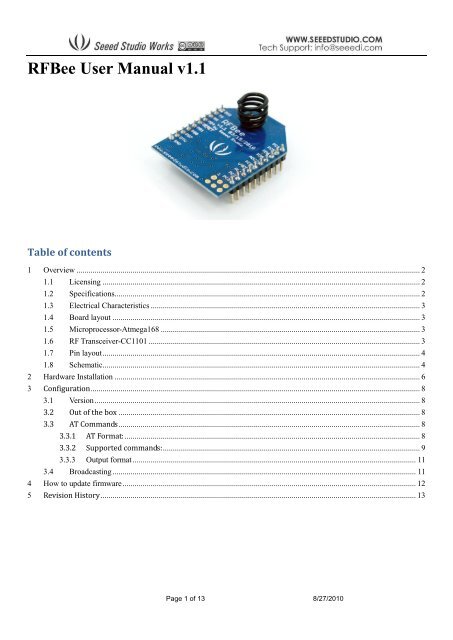
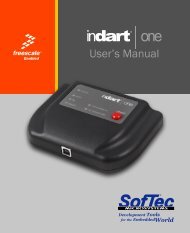
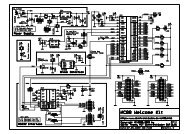
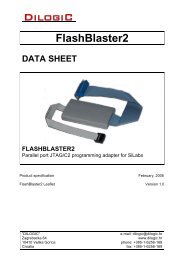
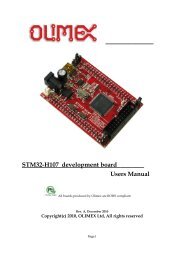

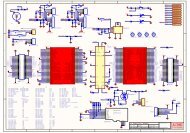
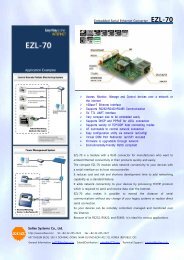
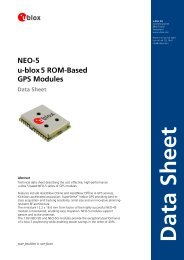

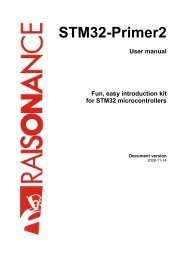
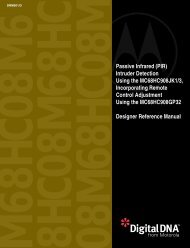
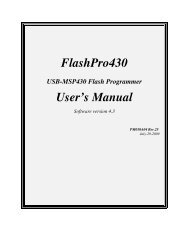
![mbed NXP LPC11U24 Schaltplan 010.2 [PDF/57KB]](https://img.yumpu.com/43869567/1/190x135/mbed-nxp-lpc11u24-schaltplan-0102-pdf-57kb.jpg?quality=85)
